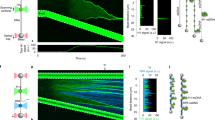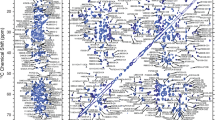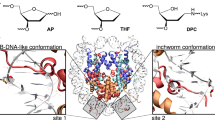Abstract
A nucleosomal core particle is composed of two each of histones H2A, H2B, H3 and H4 located inside the particle with ∼147 base pairs (bp) of DNA wrapped around the octamer in about 1.8 turns of a left-handed superhelix1,2. The path of the superhelix is not smooth; the DNA is sharply bent, or kinked, at positions symmetrically disposed at a distance of about one and four double-helical turns in both directions from the nucleosomal dyad axis (designated as sites ±1 and ±4 respectively3). This non-uniform bending is considered archetypal to other DNA-protein complexes, but its mechanism is not clear (reviewed in ref. 4). DNA-histone chemical cross-linking within the core particle has revealed strong binding of each of the two histone H4 molecules to DNA at a distance of 1.5 helical turns either side of the nucleosomal dyad axis (sites ±1.5)5,6. In each of these sites, a single flexible domain of H4 was previously shown to contact three points7, at about nucleotides 55 and 65 on one strand and nucleotide 88 on the complementary strand, numbering from the 5′ terminus of each 147-base strand; these three locations are closely juxtaposed across the highly compressed1 minor and major grooves (Fig. 1). Here we report that the amino-acid residue of histone H4 cross-linked at the 1.5 site is histidine-18, embedded in a highly basic cluster Lys-Arg-His-Arg-Lys-Val-Leu-Arg which is probably involved in the sharp bending of the DNA double helix at the ±1 sites.
This is a preview of subscription content, access via your institution
Access options
Subscribe to this journal
Receive 51 print issues and online access
$199.00 per year
only $3.90 per issue
Buy this article
- Purchase on SpringerLink
- Instant access to full article PDF
Prices may be subject to local taxes which are calculated during checkout
Similar content being viewed by others
References
Richmond, T. J., Finch, J. T., Rushton, B., Rhodes, D. & Klug, A. Nature 311, 532–537 (1984).
Uberbacher, E. C. & Bunick, G. J. J. biomolec. Struct. Dyn. 2, 1033–1055 (1985).
Klug, A., Rhodes, D., Smith, J., Finch, J. T. & Thomas, J. O. Nature 287, 509–516 (1980).
Travers, A. & Klug, A. Nature 327, 280–281 (1987).
Shick, V. V., Belyavsky, A. V., Bavykin, S. G. & Mirzabekov, A. D. J. molec. Biol. 139, 491–517 (1980).
Bavykin, S. G. et al Nucleic Acids Res. 13, 3439–3459 (1985).
Ebralidse, K. K. & Mirzabekov, A. D. FEBS Lett 194, 69–72 (1986).
Mirzabekov, A. D. et al. Meth. Enzym: Nucleosomes (ed. Wassarman, P. & Kornberg, R. D.) (Academic, Orlando, in the press).
Ebralidse, K. K., Tune'ev, V. M., Melnikova, A. F., Goguadse, E. G. & Mirzabekov, A. D. Proc. Acad. Set U.S.S.R. 265, 1272–1275 (1982).
Rhodes, D. Nucleic Acids Res. 6, 1805–1816 (1979).
Simpson, R. T. & Kunzler, P. Nucleic Acids Res. 6, 1387–1415 (1979).
Ebralidse, K. K., Grachev, S. A., Guschin, D. Yu. & Mirzabekov, A. D. Proc. Acad. Sci. U.S.S.R. (in the press).
Lambert, S. F. & Thomas, J. O. Eur. J. Biochem. 160, 191–201 (1986).
Crane–Robinson, C. et al. Eur. J. Biochem. 79, 535–548 (1977).
Wu, R. S., Panusz, H. T., Hatch, Ch. L. & Bonner, W. M. CRC Crit. Rev. Biochem. 20, 201–263 (1986).
Cockell, M., Rhodes, D. & Klug, A. J. molec. Biol. 170, 423–446 (1983).
McGhee, J. D. & Felsenfeld, G. Proc. natn. Acad. Sci. U.S.A. 76, 2133–2137 (1979).
Hogan, M. E., Rooney, Th. F. & Austin, R. H. Nature 328, 554–557 (1987).
McClarin, J. A. et al. Science 234, 1526–1541 (1986).
Anderson, J. E., Ptashne, M. & Harrison, S. C. Nature 326, 846–852 (1987).
Koudelka, G. B., Harrison, S. C. & Ptashne, M. Nature 326, 886–888 (1987).
Mirzabekov, A. D., San'ko, D. F., Kolchinsky, A. M. & Melnikova, A. F. Eur. J. Biochem. 75, 379–389 (1978).
Drew, H. R. & Travers, A. J. molec. Biol 186, 773–790 (1985).
Mirzabekov, A. D. & Rich, A. Proc. natn. Acad. Sci. U.S.A 76, 1118–1121 (1979).
Ulanovsky, L. E. & Trifonov, E. N. Nature 326, 720–722 (1987).
Langmore, J. P. & Paulson, J. R. J. cell Biol. 96, 1120–1131 (1983).
Lutter, L. C. J. molec. Biol 124, 391–420 (1978).
Alexandrov, M. L. et al Bioorg. Chemistry 11, 705–708 (1985).
Wells, D. E. Nucleic Acids Res. 14, r119–149 (1986).
Author information
Authors and Affiliations
Rights and permissions
About this article
Cite this article
Ebralidse, K., Grachev, S. & Mirzabekov, A. A highly basic histone H4 domain bound to the sharply bent region of nucleosomal DNA. Nature 331, 365–367 (1988). https://doi.org/10.1038/331365a0
Received:
Accepted:
Issue date:
DOI: https://doi.org/10.1038/331365a0
This article is cited by
-
A novel DNA/histone H4 peptide complex detects autoantibodies in systemic lupus erythematosus sera
Arthritis Research & Therapy (2016)
-
Intra- and inter-nucleosome interactions of the core histone tail domains in higher-order chromatin structure
Chromosoma (2014)
-
The effect of H3K79 dimethylation and H4K20 trimethylation on nucleosome and chromatin structure
Nature Structural & Molecular Biology (2008)
-
A 'loop recapture' mechanism for ACF-dependent nucleosome remodeling
Nature Structural & Molecular Biology (2005)
-
Topography of the ISW2–nucleosome complex: insights into nucleosome spacing and chromatin remodeling
The EMBO Journal (2004)



